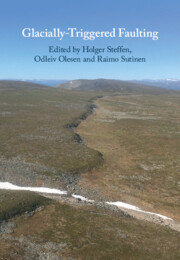Book contents
- Glacially-Triggered Faulting
- Glacially-Triggered Faulting
- Copyright page
- Contents
- Figures
- Tables
- Contributors
- Preface
- Part I Introduction
- Part II Methods and Techniques for Fault Identification and Dating
- Part III Glacially Triggered Faulting in the Fennoscandian Shield
- Part IV Glacially Triggered Faulting at the Edge and in the Periphery of the Fennoscandian Shield
- Part V Glacially Triggered Faulting Outside Europe
- 19 The Search for Glacially Induced Faults in Eastern Canada
- 20 Glacially Induced Faulting in Alaska
- 21 Indications on Glacially Triggered Faulting in Polar Areas
- Part VI Modelling of Glacially Induced Faults and Stress
- Part VII Outlook
- Index
- References
21 - Indications on Glacially Triggered Faulting in Polar Areas
from Part V - Glacially Triggered Faulting Outside Europe
Published online by Cambridge University Press: 02 December 2021
- Glacially-Triggered Faulting
- Glacially-Triggered Faulting
- Copyright page
- Contents
- Figures
- Tables
- Contributors
- Preface
- Part I Introduction
- Part II Methods and Techniques for Fault Identification and Dating
- Part III Glacially Triggered Faulting in the Fennoscandian Shield
- Part IV Glacially Triggered Faulting at the Edge and in the Periphery of the Fennoscandian Shield
- Part V Glacially Triggered Faulting Outside Europe
- 19 The Search for Glacially Induced Faults in Eastern Canada
- 20 Glacially Induced Faulting in Alaska
- 21 Indications on Glacially Triggered Faulting in Polar Areas
- Part VI Modelling of Glacially Induced Faults and Stress
- Part VII Outlook
- Index
- References
Summary
The polar region is the area surrounding the Earth’s geographical poles (Antarctica, Arctic). While glacially induced faults are well known in the formerly glaciated areas of Northern Europe, such faults within the Arctic and Antarctica are unidentified, although the theory of their physical mechanism would allow their presence. Mainly, the fact that most of the polar region is covered either by ocean (Arctic) or ice sheets (Antarctica, Greenland) prevents detailed analysis of those regions with respect to glacially induced faults. However, there are several indications that suggest an existence of glacially induced faults in the polar region. Here, we summarize findings about potential glacially induced faults in Northern Canada, Greenland, Iceland and Svalbard on the northern hemisphere and revisit the seismicity in Antarctica.
Keywords
- Type
- Chapter
- Information
- Glacially-Triggered Faulting , pp. 366 - 380Publisher: Cambridge University PressPrint publication year: 2021
References
- 1
- Cited by



